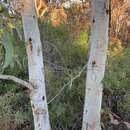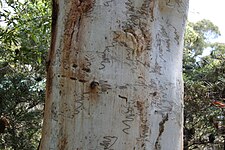tr
kırıntılardaki isimler


Eucalyptus haemastoma (lat. Eucalyptus haemastoma) - mərsinkimilər fəsiləsinin evkalipt cinsinə aid bitki növü.
Eucalyptus haemastoma ist eine Pflanzenart innerhalb der Familie der Myrtengewächse (Myrtaceae). Sie kommt nur im mittleren Küstenabschnitt von New South Wales vor[1] und wird dort „Scribbly Gum“, „Broad-leaved Scribbly Gum“, „White Gum“ oder „Snappy Gum“ genannt.[2]
Eucalyptus haemastoma wächst als Baum, der Wuchshöhen von bis zu 15 Meter erreicht. Die Borke ist am gesamten Baum glatt mit Kritzeln, weiß, grau oder gelb und schält sich in kurzen Bändern.[3][4] Die jungen Zweige besitzen eine grüne Rinde. Weder im Mark der jungen Zweige noch in der Borke gibt es Öldrüsen.[4]
Bei Eucalyptus haemastoma liegt Heterophyllie vor. Die Laubblätter sind stets in Blattstiel und Blattspreite gegliedert. Die Blattstiele sind bei einer Länge von 10 bis 20 mm schmal abgeflacht oder kanalförmig. An jungen Exemplaren ist die Blattspreite eiförmig und matt grau-grün.[3] Bei mittelalten Exemplaren ist die Blattspreite bei einer Länge von etwa 22 cm und einer Breite von etwa 8 cm eiförmig, sichelförmig gebogen, ganzrandig und matt grau-grün.[4] Die auf Ober- und Unterseiten gleichfarbig glänzend grünen oder grau-grünen Laubblätter an erwachsenen Exemplaren sind bei einer Länge von 12 bis 15 cm und einer Breite von 1,5 bis 4 cm breit-lanzettlich,[3] relativ dick, sichelförmig gebogen, verjüngen sich zur Spreitenbasis hin und besitzen ein spitzes oberes Ende. Die kaum erkennbaren Seitennerven gehen in mittleren Abständen in einem spitzen Winkel in großen Abständen vom Mittelnerv ab. Die Keimblätter (Kotyledone) sind nierenförmig.[4]
Seitenständig an einem bei einer Länge von 12 bis 25 mm und einer Breite von bis zu 3 mm im Querschnitt schmal abgeflachten oder kantigen Blütenstandsschaft stehen in einem einfachen Blütenstand elf oder mehr Blüten zusammen. Die 3 bis 6 mm langen Blütenstiele sind stielrund. Die nicht blaugrün bemehlt oder bereiften Blütenknospen sind bei einer Länge von 6 bis 8 mm und einem Durchmesser von 4 bis 5 mm ei- oder keulenförmig.[3] Die Kelchblätter bilden eine Calyptra, die bis zur Blüte (Anthese) vorhanden bleibt. Die glatte Calyptra ist halbkugelig oder konisch, ebenso lang wie der glatte Blütenbecher (Hypanthium)[4] oder kürzer und schmaler als dieser. Die äußeren Staubblätter sind unfruchtbar.[3] Die Blüten sind cremeweiß oder gelb.[4]
Die gestielte[4] Frucht ist bei einer Länge und einem Durchmesser von je von 6 bis 9 mm konisch oder birnenförmig[3][4] und vierfächerig.[4] Der Diskus ist flach oder leicht angehoben, die Fruchtfächer sind eingeschlossen oder stehen auf der Höhe des Randes.[4][3]
Das natürliche Verbreitungsgebiet von Eucalyptus haemastoma ist der mittlere Küstenabschnitt von New South Wales, um Sydney und Newcastle,[1] vom Lake Macquarie bis zum Royal-Nationalpark.[3]
Eucalyptus haemastoma wächst örtlich häufig in trockenen Hartlaubwäldern auf flachen, unfruchtbaren Sandböden über Sandstein.[3][4]
Die Erstbeschreibung von Eucalyptus haemastoma erfolgte 1797 durch James Edward Smith unter dem Titel Botanical Charakters of Some Plants of the Natural Order of Myrti in Transactions of the Linnean Society of London, Volume 3, S. 286.[2][5][6] Synonyme von Eucalyptus haemastoma Sm. sind Eucalyptus haemastoma Sm. subsp. haemastoma und Eucalyptus haemastoma Sm. var. haemastoma.[2]
Intergradationen mit Eucalyptus racemosa wurden hauptsächlich südlich von Sydney beobachtet.[3] Natürliche Hybriden bildet Eucalyptus haemastoma mit Eucalyptus piperita subsp. piperita, Eucalyptus umbra und Eucalyptus camfieldii.[2] Bei „Australian Plant Name Index“[2] wird eine Varietät als Hybride erwähnt: Eucalyptus haemastoma var. ×montana H.Deane & Maiden.
Eucalyptus haemastoma ist eine Pflanzenart innerhalb der Familie der Myrtengewächse (Myrtaceae). Sie kommt nur im mittleren Küstenabschnitt von New South Wales vor und wird dort „Scribbly Gum“, „Broad-leaved Scribbly Gum“, „White Gum“ oder „Snappy Gum“ genannt.
Eucalyptus haemastoma, commonly known as scribbly gum,[2] is a species of tree that is endemic to the Sydney region. It has white or silvery grey bark, lance-shaped or curved adult leaves, flower buds in groups of between nine and fifteen, white flowers and conical or hemispherical fruit. It is one of several eucalypts with prominent and differing insect scribbles in the bark, caused by the larvae of Ogmograptis, (and in the case of E. haemostoma - probably O. racemosa).[3]

Eucalyptus haemastoma is a tree that typically grows to a height of 12–15 m (39–49 ft) and forms a lignotuber. It has smooth white, silvery grey or yellow bark with insect scribbles. Young plants and coppice regrowth have elliptical to oblong or egg-shaped leaves that are 70–150 mm (2.8–5.9 in) long and 20–60 mm (0.79–2.36 in) wide. Adult leaves are lance-shaped or curved, the same shade of green on both sides, 90–210 mm (3.5–8.3 in) long and 15–35 mm (0.59–1.38 in) wide on a petiole 12–20 mm (0.47–0.79 in) long. The flower buds are arranged in leaf axils in groups of between nine and fifteen on an unbranched peduncle 5–25 mm (0.20–0.98 in) long, the individual buds on pedicels 3–7 mm (0.12–0.28 in) long. Mature buds are oval, 4–6 mm (0.16–0.24 in) long and 3–4 mm (0.12–0.16 in) wide with a conical to rounded operculum. Flowering occurs between July and November and the flowers are white. The fruit is a woody, conical or hemispherical capsule 5–9 mm (0.20–0.35 in) long and 7–11 mm (0.28–0.43 in) wide with the valves near rim level.[2][4][5][6]
This species intergrades with E. racemosa, also a scribbly gum, mainly in the south of the Sydney area.[5] A third scribbly gum, E. rossii is found further inland, on the slopes and tablelands between Tenterfield and Bombala.[7]
Eucalyptus haemastoma was first formally described in 1797 by James Edward Smith in Transactions of the Linnean Society of London.[8][9] Smith noted "[f]ruit globose, cut off at the summit, its orifice surrounded by a broad deep-red border". The specific epithet is derived from the Greek haima, 'blood' and stoma, 'mouth', referring to the reddish disc of the fruit.[2]
This scribbly gum grows in woodland on shallow sandy soil derived from sandstone. It occurs in the Sydney region between Lake Macquarie and the Royal National Park.
Eucalyptus haemastoma, commonly known as scribbly gum, is a species of tree that is endemic to the Sydney region. It has white or silvery grey bark, lance-shaped or curved adult leaves, flower buds in groups of between nine and fifteen, white flowers and conical or hemispherical fruit. It is one of several eucalypts with prominent and differing insect scribbles in the bark, caused by the larvae of Ogmograptis, (and in the case of E. haemostoma - probably O. racemosa).
 bark of E. haemastoma at Picnic Point
bark of E. haemastoma at Picnic Point flower buds
flower buds fruit
fruit
Eucalyptus haemastoma est un arbre australien de la famille des Myrtaceae qui doit son nom aux sillons sinueux qui parcourent son écorce. Ces sillons sont les anciens tunnels creusés par une chenille (Ogmograptis scribula) pendant son existence. Le papillon femelle dépose ses œufs entre la vieille et la nouvelle écorce. La chenille se creuse un chemin dans la nouvelle écorce, chemin de plus en plus large au fur et à mesure que la chenille grandit et qui s'arrête à l'endroit où elle se transforme en chrysalide et qui deviendra apparent lorsque la vieille écorce tombera.
Eucalyptus haemastoma est un arbre d'une quinzaine de mètres de haut (occasionnellement un mallee). L'écorce est lisse, d'un blanc gris. Les jeunes feuilles sont pétiolées, ovales ou incurvées, pendantes, d'un vert bleu et mesurent environ 22 cm de long sur 8 de large. Les feuilles adultes sont pétiolées, lancéolées ou incurvées, concolores, d'un vert brillant et mesurent 15 cm de long sur 3 de large. Les fleurs, blanches, apparaissent à la fin du printemps et au début de l'été. Les fruits sont en forme de poire.
On ne le trouve naturellement que dans les plaines côtières et sur les collines de la région de Sydney.
Eucalyptus haemastoma est un arbre australien de la famille des Myrtaceae qui doit son nom aux sillons sinueux qui parcourent son écorce. Ces sillons sont les anciens tunnels creusés par une chenille (Ogmograptis scribula) pendant son existence. Le papillon femelle dépose ses œufs entre la vieille et la nouvelle écorce. La chenille se creuse un chemin dans la nouvelle écorce, chemin de plus en plus large au fur et à mesure que la chenille grandit et qui s'arrête à l'endroit où elle se transforme en chrysalide et qui deviendra apparent lorsque la vieille écorce tombera.
Eucalyptus haemastoma est un arbre d'une quinzaine de mètres de haut (occasionnellement un mallee). L'écorce est lisse, d'un blanc gris. Les jeunes feuilles sont pétiolées, ovales ou incurvées, pendantes, d'un vert bleu et mesurent environ 22 cm de long sur 8 de large. Les feuilles adultes sont pétiolées, lancéolées ou incurvées, concolores, d'un vert brillant et mesurent 15 cm de long sur 3 de large. Les fleurs, blanches, apparaissent à la fin du printemps et au début de l'été. Les fruits sont en forme de poire.
On ne le trouve naturellement que dans les plaines côtières et sur les collines de la région de Sydney.
Eucalyptus haemastoma là một loài thực vật có hoa trong Họ Đào kim nương. Loài này được Sm. mô tả khoa học đầu tiên năm 1797.[1]
Eucalyptus haemastoma là một loài thực vật có hoa trong Họ Đào kim nương. Loài này được Sm. mô tả khoa học đầu tiên năm 1797.
Eucalyptus haemastoma Sm.
АреалЭвкалипт кровяно-дисковый (лат. Eucalyptus haemastoma) — вечнозелёное дерево, вид рода Эвкалипт (Eucalyptus) семейства Миртовые (Myrtaceae).
В природе ареал охватывает юго-восток Австралии — Голубые горы, штат Виктория (район Бичворта) и побережье Нового Южного Уэльса от залива Джервис на юге до Кемпси на севере.
Отличается средней морозостойкостью. Во взрослом состоянии выдерживает без повреждений кратковременное понижение температуры до -8… -7 °C, при -9 °C повреждаются листья. Молодые растения при понижении температуры до —9 °C отмерзают до корня. Продолжительные морозы в 9—10 °C убивают надземную часть дерева.
Растёт на довольно бедных песчаных почвах. Засухоустойчив. Отличается относительно быстрым ростом на глубоких наносных почвах. На глинистых склонах и каменистых почвах растёт медленно; за 10 лет деревья здесь достигают высоты лишь в 10 м, при диаметре ствола 14 см.
Дерево высотой до 15 м, иногда растущее кустообразно.
Кора гладкая, с зелёными и голубыми пятнами.
Молодые листья супротивные, в числе 3—4 пар, на укороченных черешках, продолговатые или почти округлые, длиной 4—5 см, шириной 2—3 см, толстые, кожистые, почти сизые. Промежуточные листья очерёдные, короткочерешковые, широко ланцетные, длиной 7—14 см, шириной 3—6 см, толстые, кожистые. Взрослые — очерёдные, черешковые, ланцетные, большей частью серповидно изогнутые, длиной 8—18 см, шириной 2—3 см, толстые, кожистые.
Зонтики пазушные, 5—12-цветковые, редко в коротеньких верхушечных метёлках; ножка зонтика плоская, длиной 10—15 мм; бутоны на цветоножках, булавовидные, длиной 6 мм, диаметром 5 мм, слегка угловатые, с полушаровидной крышечкой, которая короче вытянутой трубки цветоложа; пыльники почковидные, слегка качающиеся, с гнёздами, открывающимися сливающимися продольными щелями.
Плоды на ножках, грушевидные, длиной 7—9 мм, диаметром 9—10 мм, с широким, плоским или выпуклым, красноватым диском и короткими, вдавленными створками.
На родине цветёт в марте — июне и сентябре — декабре; на Черноморском побережье Кавказа — в августе.
Древесина красная, очень ломкая, в земле умеренно прочная; используется на столбы и на топливо.
В листьях содержится эфирное эвкалиптовое масло (0,44 %), состоящее из фелландрена, цинеола и сесквитерпенов.
В рамках виды выделяют несколько разновидностей[2]:
Вид Эвкалипт кровяно-дисковый входит в род Эвкалипт (Eucalyptus) подсемейства Миртовые (Myrtoideae) семейства Миртовые (Myrtaceae) порядка Миртоцветные (Myrtales).
Эвкалипт кровяно-дисковый (лат. Eucalyptus haemastoma) — вечнозелёное дерево, вид рода Эвкалипт (Eucalyptus) семейства Миртовые (Myrtaceae).